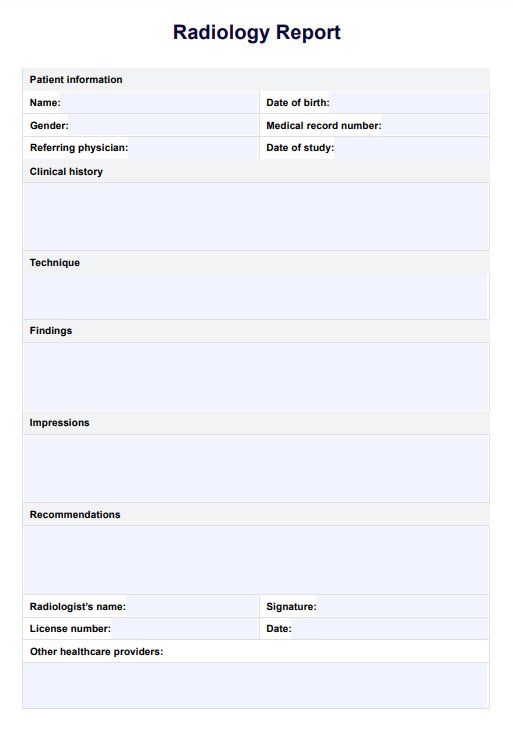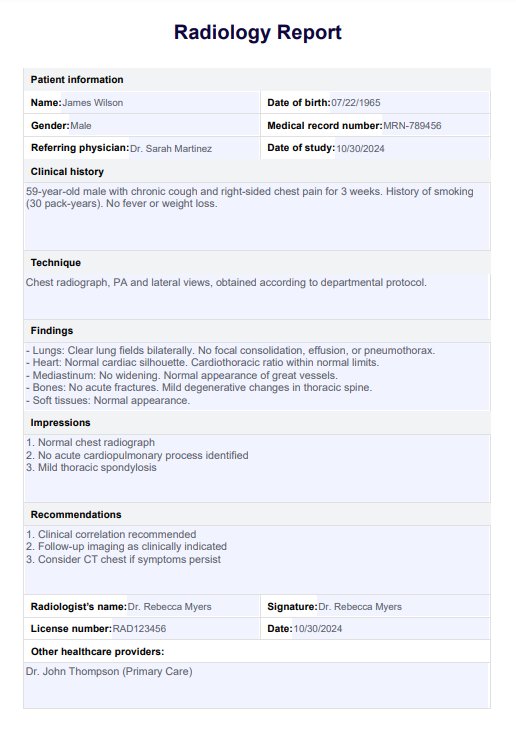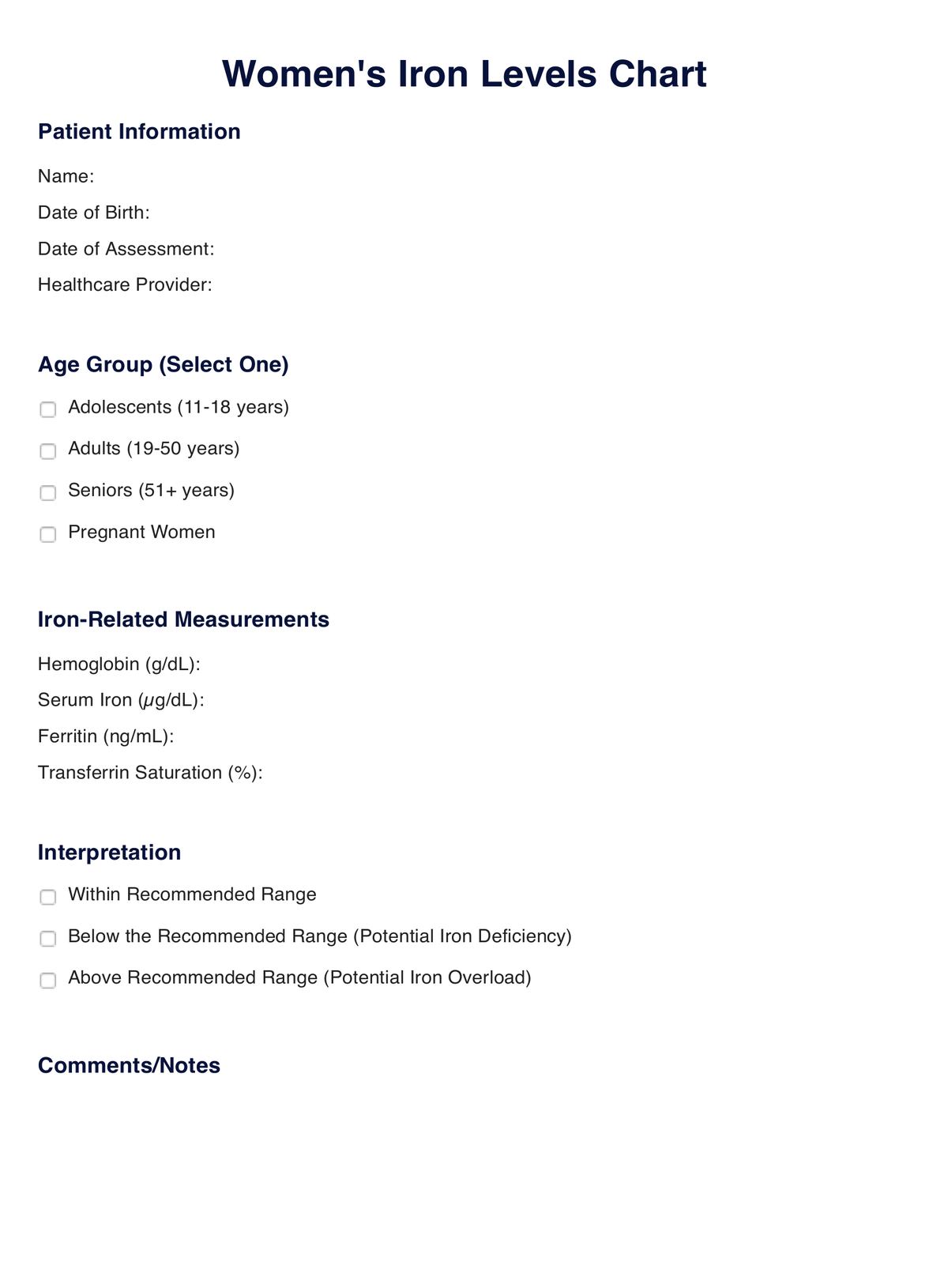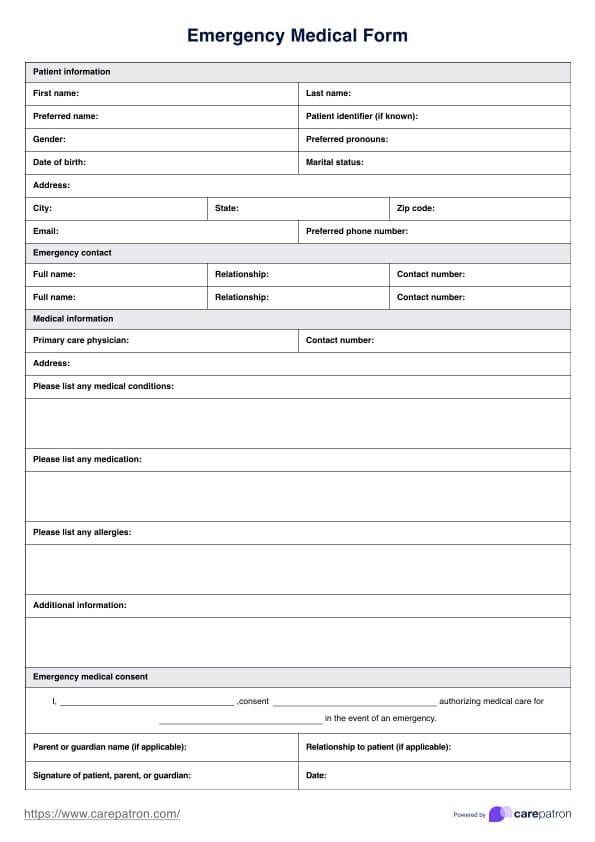Radiology Report Template
Get a free Radiology Report Template for easy clinical documentation. Download the PDF and example here.


What is a radiology test?
A radiology or medical imaging test is a diagnostic procedure to visualize the body's internal structures. This includes using X-rays, ultrasound, MRI, CT scans, and nuclear medicine, including bones, organs, and tissues.
Physicians commonly order radiology tests to help diagnose and monitor various medical conditions. These tests can help identify abnormalities, assess the extent of injuries or diseases, and guide treatment options. Some common types of radiology tests include:
- X-rays: Uses small amounts of radiation to produce images of bones, lungs, and other internal structures.
- Magnetic resonance imaging (MRI): Uses a strong magnetic field and radio waves to produce detailed images of organs and tissues.
- Computed tomography (CT) scan: Uses X-rays and computer technology to produce cross-sectional body images.
- Nuclear medicine: Uses small amounts of radioactive material to diagnose and treat diseases.
Radiology Report Template
Radiology Report Template Example
Why is a radiology report important?
A radiology report is a crucial document that conveys the findings of a radiology test to referring physicians. It represents the radiologist's expert interpretation of the imaging studies, providing valuable information for differential diagnosis, treatment planning, and follow-up care.
The accuracy and clarity of these reports play a vital role in clinical decision-making, as they are integral to the continuum of patient care and improved patient outcomes. They offer a comprehensive review of the patient's condition and help assess the progression or resolution of a condition over time.
According to the Radiological Society of North America (n.d.), structured reports are essential for radiologists to convey their diagnostic input. Consistent, standardized reporting templates reduce confusion and enhance communication among healthcare professionals.
What is included in a radiology report?
A radiology report should include essential elements such as (American College of Radiology, 2014):
- Common data elements: The report should include specific patient data such as the location and description of the abnormality, any relevant medical history or symptoms provided, pertinent laboratory findings, and any other additional information.
- Imaging technique section: A description of the imaging modality used. For example, CT scan, MRI, x-ray, etc.
- Description of imaging findings: This section provides a detailed analysis of what the radiologist has observed during the exam. It includes information about abnormalities or structures' size, shape, and appearance.
- Impression: This summary statement includes the radiologist's interpretation of the imaging findings and any further tests or treatment recommendations.
- Recommendation: This section outlines the radiologist's suggested next steps, such as follow-up imaging or consultations with other specialists.
How does our Radiology Report Template work?
Referring physicians, a radiologist interpreting imaging studies, and other healthcare professionals can use our free Radiology Report Template to create comprehensive and standardized reports for their patients quickly. Here's how to get started:
Step 1: Download the form
Get a copy of the structured report template using the link on this page. You may also get it from the Carepatron app or through this guide.
Step 2: Use the digital format or print a copy
You can use the digital version of our template, which can be filled out electronically. Alternatively, you can also print a paper copy and fill it in by hand.
Step 3: Fill in the required information
To complete the report, enter all necessary patient data, including any relevant history, laboratory findings, and recommendations. Use the designated sections to describe findings and impressions. For instance, you can write "no pericardial effusion" or "evidence of a fracture in the distal radius". You can refer to our sample template for a guide on how to accomplish this tool.
Step 4: Double-check and validate
Before submitting the report, review and verify all information for accuracy. Structured reporting drastically reduces the chances of mistakes, but it's always important to double-check.
Step 5: Submit the report
Once you have completed all sections and validated the information, submit the report to the appropriate parties involved in patient care. This may include referring physicians or other specialists needing to review the findings.
What are the benefits of having a Radiology Report Template?
Here are several benefits of using Carepatron's free Radiology Report Template:
Fully digital
You can complete the report electronically, saving time and avoiding the hassle of printing and scanning. It also makes submitting the results to the referring physician quicker and easier.
User-friendly and easy-to-customize
Our template is designed to be easy to use, with clearly labeled sections for necessary information. You can also modify the template to fit your specific reporting needs. You can add information like a consensus statement, critical findings, or additional images.
Standardized format
A standardized format for radiology reports ensures all necessary information is included and organized logically. This makes it easier for other healthcare professionals to understand and interpret the results.
Decreased errors
Using our Radiology Report Template can significantly reduce the risk of errors or omissions in the report. Medical practices with a standardized reporting process typically have fewer mistakes and more accurate results.
References
American College of Radiology. (2014). ACR practice parameter for communication of diagnostic imaging findings. https://www.acr.org/-/media/ACR/NOINDEX/Advocacy/Advocacy-News/Comm_Diag_Imaging.pdf?la=en
Radiological Society of North America. (n.d.). RadReport reporting templates. https://www.rsna.org/practice-tools/data-tools-and-standards/radreport-reporting-templates
Commonly asked questions
A radiology report should be written after a diagnostic imaging procedure has been completed and a radiologist has reviewed the images.
Yes, you can modify this template to fit your practice's needs and preferences within the Carepatron platform.
Radiologists, radiology technologists, and other healthcare providers use structured report templates to document their findings from diagnostic imaging procedures and communicate them with referring physicians.
















































































































